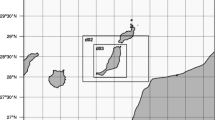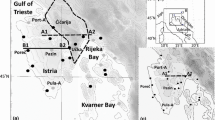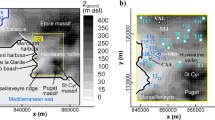Abstract
In-situ sodar and lidar measurements were coupled with numerical simulations for studying a sea-breeze event in a flat coastal area of the North Sea. The study’s aims included the recognition of the dynamics of a sea-breeze structure, and its effects on the lower troposphere stratification and the three-dimensional (3D) pollutant distribution. A sea breeze was observed with ground-based remote sensing instruments and analysed by means of numerical simulations using the 3D non-hydrostatic atmospheric model Meso-NH. The vertical structure of the lower troposphere was experimentally determined from the lidar and sodar measurements, while numerical simulations focused on the propagation of the sea breeze inland. The sea-breeze front, the headwind, the thermal internal boundary layer, the gravity current and the sea-breeze circulation were observed and analysed. The development of a late stratification was also observed by the lidar and simulated by the model, suggesting the formation of a stable multilayered structure. The transport of passive tracers inside the sea breeze and their redistribution above the gravity current was simulated too. Numerical modelling showed that local pollutants may travel backward to the sea above the gravity current at relatively low speed due to the shearing between the landward gravity current and the seaward synoptic wind. Such dynamic conditions may enhance an accumulation of pollutants above coastal industrial areas.
Similar content being viewed by others
References
Abbs DJ (1986). Sea breeze interactions along a concave coastline in southern Australia: observations and numerical modeling study. Mon Wea Rev 114: 831–848
Augustin P, Delbarre H, Lohou F, Campistron B, Puygrenier V, Cachier H and Lombardo T (2006). Investigation of local meteorological events and their relationship with ozone and aerosols during an ESCOMPTE photochemical episode. Ann Geophys 24: 2809–2822
Beyrich F (1996). Boundary-layer structure and photochemical pollution in the Harz Mountains—An observational study. Atmos Environ 30: 1271–1281
Beyrich F (1997). Mixing height estimation from sodar data—a critical discussion. Atmos Environ 31: 3941–3953
Boone A, Calvet JC and Noilhan J (1999). Inclusion of a third soil layer in a land-surface scheme using the force-restore method. J Appl Meteorol 38: 1611–1630
Bougeault P and Lacarrere P (1989). Parametrization of orography induced turbulence in a mesobeta-scale model. Mon Wea Rev 117: 1872–1890
Bougeault P, Sadourny R (2001) Dynamique de l’Océan et de l’atmosphère. In: de l’Ecole Polytechnique (ed), Palaiseau, France, 298 pp
Calvet JC, Noilhan J, Roujean JL, Bessemoulin P, Cabelguenne M, Olioso A and Wigneron JP (1998). An interactive vegetation SVAT model tested against data from six contrasting sites. Agric Forest Meteorol 92: 73–95
Charnock H (1955). Wind stress on a water surface. Quart J Roy Meteorol Soc 81: 639–640
Cuxart J, Bougeault P and Redelsperger JL (2000). A turbulence scheme allowing for mesoscale and large-eddy simulations. Quart J Roy Meteorol Soc 126: 1–30
Deardorff JW (1972). Numerical investigation of neutral and unstable planetary boundary layers. J Atmos Sci 29: 91–115
Delbarre H, Augustin P, Saïd F, Campistron B, Bénech B, Lohou F, Puygrenier V, Moppert C, Cousin F, Fréville P and Fréjafon E (2005). Ground-based remote sensing observation of the complex behaviour of the Marseille boundary layer during ESCOMPTE. Atmos Res 74: 403–433
Déqué M, Drevton A, Braun A and Cariolle D (1994). The ARPEGE/IFS atmosphere model: a contribution to the French community climate modelling. Climate Dyn 10: 249–266
Durand P, Briere S and Druilhet A (1989). A sea-land transition observed during the coast experiment. J Atmos Sci 46: 96–116
Finkele K, Hacker JM, Kraus H and Byron-Scott RAD (1995). A complete sea-breeze circulation cell derived from aircraft observations. Boundary-Layer Meteorol 73: 299–317
Finkele K (1998). Inland and offshore propagation speeds of a sea breeze from simulation and measurements. Boundary-Layer Meteorol 87: 307–329
Frizzola JA and Fisher EL (1963). A series of sea-breeze observations in the New-York city area. J Appl Meteorol 2: 722–739
Garratt JR (1990). The Internal Boundary-Layer—A review. Boundary-Layer Meteorol 50: 171–203
Garratt JR (1992) The atmospheric boundary-layer. Cambridge University Press, Cambridge, UK, 316 pp
Gilliam RC, Raman S and Devdutta S Niyogi (2004). Observational and numerical study on the influence of large-scale flow direction and coastline shape on sea-breeze evolution. Boundary-Layer Meteorol 111: 275–300
Gossard EE, Gaynor JE, Zamora JE and Neff WD (1985). Finestructure of elevated stable layers observed by sounder and in situ tower sensors. J Atmos Sci 42: 2156–2169
Harris L and Kotamarthi VR (2005). The characteristics of the Chicago Lake breeze and its effects on trace particle transport: results from an episodic event simulation. J Appl Meteorol 44: 1637–1654
Holton JR (1992) An Introduction to dynamic meteorology. In: Int Geophys Ser (3rd edn.), Vol 48. Academic Press, London, UK, 511 pp
Jamima P and Lakshminarasimhan J (2004). Numerical simulation of sea-breeze characteristics observed at tropical coastal site, Kalpakkam. Proc Indian Acad Sci (Earth Planet Sci) 113: 197–209
Kambezidis HD, Weidauer D, Melas D and Ulbricht M (1998). Air quality in the Athens basin during sea-breeze and non-sea-breeze days using laser remote sensing technique. Atmos Environ 32: 2173–2182
Kolev IN, Skakalova TS, Parvanov O, Kaprielov BK, Donev E and Ivanov CD (1996). Lidar visualization of the aerosol stratification and the internal boundary layer in the coastal area in the case of breeze circulation. Proc SPIE 3052: 300–305
Kölsch HJ, Rairoux P, Wolf JP and Wöste L (1992). Comparative study of nitric oxide immission in the cities of Lyon, Geneva and Stuttgart using a mobile differential absorption lidar system. Appl Phys B 54: 89–94
Kouchi A, Ohba R and Shao Y (1999). Gas diffusion in a convection layer near a coastal region. J Wind Eng Ind Aerod 81: 171–180
Kunz GJ, Becker E, O’Dowd CD and Leeuw G (2002). Lidar observations of atmospheric boundary layer structure and sea spray aerosol plumes generation and transport at Mace Head, Ireland (PARFORCE experiment). J Geophys Res 107: 1–14
Lafore JP, Stein J, Asencio N, Bougeault P, Ducrocq V, Duron J, Fischer C, Héreil P, Mascart P, Masson V, Pinty JP, Redelsperger JL, Richard E and Vilà-Gueraude Arellano J (1998). The Meso-NH atmospheric simulation system. Part I: adiabatic formulation and control simulations. Ann Geophys 16: 90–109
Luhar AK, Sawford BL, Hacker JM and Rayner KN (1998). The Kwinana coastal fumigation study: 2—growth of the thermal internal boundary layer. Boundary-Layer Meteorol 89: 385–405
Mahrt L (1999). Stratified atmospheric boundary layers. Boundary-Layer Meteorol 90: 375–396
Masson V (2000). A physically-based scheme for the urban energy budget in atmospheric models. Boundary-Layer Meteorol 94: 357–397
Melfi SH, Spinhirne JD, Chou SH and Palm SP (1985). Lidar observations of the vertically organized convection in the planetary boundary layer over ocean. J Clim Appl Meteorol 24: 806–821
Menut L, Flamant C, Pelon J and Flamant PH (1999). Urban boundary layer height determination from lidar measurements over the Paris area. Appl Opt 38: 945–954
Miao JF, Kroon LJM, Vilà-Gueraude Arellano J and Holtslag AAM (2003). Impacts of topography and land degradation on the sea breeze over eastern Spain. Meteorol Atmos Phys 84: 157–170
Miller STK, Keim BD, Talbot RW and Mao H (2003). Sea breeze: structure, forecasting, and impacts. Rev Geophys 41: 1/1–31
Morcrette JJ (1991). Radiation and cloud radiative properties in the European center for medium range weather forecasts forecasting system. J Geophys Res 96: 9121–9132
Nazir M, Khan FI and Husain T (2005). Revised estimates for continuous shoreline fumigation: a PDF approach. J Hazard Mater A 118: 53–65
Noilhan J and Planton S (1989). A simple parameterization of land surface processes for meteorological models. Mon Wea Rev 117: 536–549
Noilhan J and Mahfouf JF (1996). The ISBA land surface parametrization scheme. Glob Planet Change 13: 145–159
Oh IB, Kim YK, Lee HW and Kim CH (2006). An observational and numerical study of the effects of the late sea breeze on ozone distributions in the Busan metropolitan area, Korea. Atmos Environ 40: 1284–1298
Ohba R, Shao Y and Kouchi A (1998). A wind tunnel and numerical investigation of turbulent dispersion in coastal atmospheric boundary layers. Boundary-Layer Meteorol 87: 255–273
Pedlosky J (1986) Geophysical fluid dynamics, 2nd edn. Springer-Verlag, 710 pp
Physick WL (1980). Numerical experiments on the inland penetration of the sea breeze. Quart J Roy Meteorol Soc 106: 735–746
Puygrenier V, Lohou F, Campistron B, Saïd F, Pigeon G, Benech B and Serça D (2005). Investigation on the fine structure of sea breeze during ESCOMPTE experiment. Atmos Res 74: 329–353
Rao MP, Casadio S, Fiocco G, Lena F, Cacciani M, Calisse PG, Fua D and Sarra A (1995). Observation of lump structures in the nocturnal atmospheric boundary layer with Doppler sodar and Raman lidar. Geophys Res Lett 22: 2505–2508
REMTECH (2000) Sodar manual. Remtech 98 pp
Simpson JE (1994) Sea breeze and Local Wind. Cambridge University Press, Cambridge, UK, 234 pp
Srinivas CV and Venkatesan R (2005). A simulation study of dispersion of air borne radionuclides from a nuclear power plant under a hypothetical accidental scenario at a tropical coastal site. Atmos Environ 39: 1497–1511
Steyn DG (1998). Scaling the vertical structure of sea breezes. Boundary-Layer Meteorol 86: 505–524
Steyn DG (2003). Scaling the vertical structure of sea breezes revisited. Boundary-Layer Meteorol 107: 177–188
Stull RB (1988) An Introduction to Boundary Layer Meteorology. Kluwer Academic Publishers, Dordrecht, the Netherlands, 666 pp
Thomasson A, Geffroy S, Fréjafon E, Weidauer D, Fabian R, Godet Y, Nominé N, Ménard T, Rairoux P, Moeller D and Wolf JP (2002). LIDAR mapping of ozone-episode dynamics in Paris and intercomparison with spot analysers. Appl Phys B 74: 453–459
Venkatram A (1986). An examination of methods to estimate the height of the coastal internal boundary layer. Boundary-Layer Meteorol 36: 149–156
Author information
Authors and Affiliations
Corresponding author
Rights and permissions
About this article
Cite this article
Talbot, C., Augustin, P., Leroy, C. et al. Impact of a sea breeze on the boundary-layer dynamics and the atmospheric stratification in a coastal area of the North Sea. Boundary-Layer Meteorol 125, 133–154 (2007). https://doi.org/10.1007/s10546-007-9185-6
Received:
Accepted:
Published:
Issue Date:
DOI: https://doi.org/10.1007/s10546-007-9185-6




